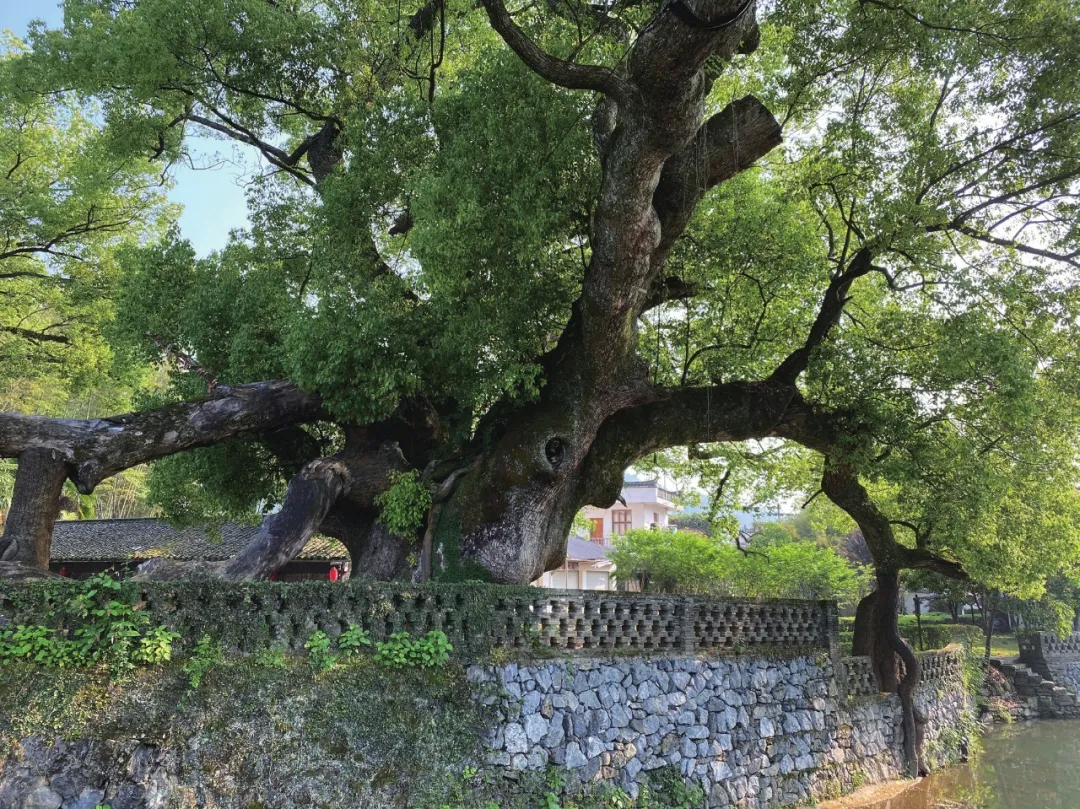景觀滋養(yǎng)了人類的身體和心靈,連同人類的欲望——從生存和生理需求,到歸屬感與認(rèn)同感的獲得,再到自我價(jià)值的實(shí)現(xiàn),也都應(yīng)景觀而生。
2020年5月3日 俞孔堅(jiān)攝于江西省婺源縣嚴(yán)田村
婺源“天下第一樟”。在中國(guó)徽州地區(qū)���,村口的古樹(shù)往往是由歷史上躲避戰(zhàn)亂、到此重建家園的祖先栽下����,有著與村莊同樣悠久的歷史,并承載著村民的全部期許�����。它們承載了人們?cè)谀吧耐恋厣汐@得立錐之地的期望����,以及對(duì)平安���、健康�、良緣佳偶與兒孫滿堂的祈愿,是從生存與安全等基本欲望到歸屬感與認(rèn)同感等高層次欲望的表達(dá)�,亦逐漸成為子孫后代對(duì)這方土地的歸屬與認(rèn)同的標(biāo)志。在這里����,人類的欲望與自然景觀和諧共生,并經(jīng)由自然提供的景觀服務(wù)得到了滿足��。
俞孔堅(jiān)
北京大學(xué)建筑與景觀設(shè)計(jì)學(xué)院教授�����;美國(guó)藝術(shù)與科學(xué)院院士
原文刊發(fā)時(shí)間:2020年12月
景觀滋養(yǎng)了人類的身體和心靈��,連同人類的欲望——從生存和生理需求����,到歸屬感與認(rèn)同感的獲得,再到自我價(jià)值的實(shí)現(xiàn)�����,也都應(yīng)景觀而生。
從脫離樹(shù)棲��、以雙腳立于地面的第一天開(kāi)始��,人類便在生存欲望的驅(qū)使下����,游獵于草原與森林的邊緣,垂涎著成群的食草動(dòng)物�����,并時(shí)刻警惕著潛伏在高草中的猛獸�����;學(xué)習(xí)判別地形和地貌����、原野上的石頭與草木走獸的益害;學(xué)習(xí)運(yùn)用感官尋覓伴侶�,并尋找安全的棲居地,以滿足繁衍的欲望����。進(jìn)化人類學(xué)和進(jìn)化美學(xué)認(rèn)為�����,正是生存和繁衍這兩大基本欲望�,培育了人類對(duì)于景觀的感知和審美[1] :與人類的生存欲望相關(guān)的景觀結(jié)構(gòu)和元素�,成為喚起崇高的刺激��;與人類繁衍欲望相關(guān)的景觀���,成為喚起優(yōu)美的風(fēng)景[2] ��。這當(dāng)然是高度簡(jiǎn)化的景觀特征與人類情感的關(guān)系模式���,而景觀也因此被賦予了意義:荒原上的一棵孤樹(shù)如同大海中的一個(gè)島嶼,便是生的 希望����;崖壁上的平地和山間的洞穴,承載著人類個(gè)體和群體的延續(xù)�����。
人類的欲望也造就了大地上的文化景觀�����。歷史的景觀是過(guò)往人類的欲望在大地上的烙印,現(xiàn)實(shí)的景觀便是當(dāng)今人類的欲望在大地上的耕耘��。綿延的牧場(chǎng)�����、農(nóng)田及連片果園��,都是人類欲望的展現(xiàn)���,煙囪林立的工業(yè)區(qū)和不斷蔓延的城市更是人類欲望膨脹的寫(xiě)照�;無(wú)論是橫亙于山脊大漠之上的長(zhǎng)城�,還是穿鑿于黃河長(zhǎng)江之間的大運(yùn)河,都是人類對(duì)自然征服欲的具現(xiàn)�;無(wú)論是凡爾賽宮園林還是頤和園,都是法國(guó)王室和中國(guó)皇家統(tǒng)治欲望的展現(xiàn)���;無(wú)論是古羅馬的凱旋門���,還是第三帝國(guó)的勝利林蔭道,抑或是今天泛濫于中國(guó)城市的恢弘廣場(chǎng)和超大尺度的景觀大道���,無(wú)不是城市決策者權(quán)利欲望的流露與宣示����。
欲望是無(wú)止境的,因而人類對(duì)景觀的營(yíng)造或改變存在著無(wú)節(jié)制的風(fēng)險(xiǎn)����,甚至?xí)?lái)破壞。從人類進(jìn)化和發(fā)展的歷史來(lái)看����,人類并沒(méi)有約束自我欲望的基因�,卻在追求欲望滿足的過(guò)程 中不斷暴露出攫取、擴(kuò)張的貪婪本性——擁有財(cái)富和權(quán)力的權(quán)貴們的宮殿和園林無(wú)限制擴(kuò)大�����,以便收儲(chǔ)不斷膨脹和更新的欲望����。技術(shù)進(jìn)步和工業(yè)化大生產(chǎn)在滿足資本家的財(cái)富野心的同時(shí),也讓更多的人在欲望的驅(qū)使下��,試圖更高效地攫取自然資源:農(nóng)田��、工廠和城市因此不斷蔓延,農(nóng)藥�、化肥因此被無(wú)節(jié)制地使用。這一切都致使人類唯一的家園面臨巨大危機(jī):氣候變化���、洪澇頻發(fā)���、海平面上升,大地景觀正在經(jīng)歷劇變�����,人類或?qū)⒆陨砺裨嵩谟纳顪Y之中��。如圣雄甘地所言:“地球上提供給我們的物質(zhì)財(cái)富足以滿足每個(gè)人的需求�����,但不足以滿足每個(gè)人的貪欲�。” [3]
幸好���,欲望是可以和自然和諧共生的���。當(dāng)最基本的生理和安全需求得到保障以后�����,人類可以通過(guò)合理利用自然景觀的服務(wù)�����,而不是一味消耗自然資產(chǎn)����,來(lái)滿足其他更高層次的需求���。為了滿足對(duì)認(rèn)同和歸屬感的欲望�����,人們可以開(kāi)采大量的石材,用盡人力物力�,來(lái)建造高聳入云的紀(jì)念碑和宏大的廟宇,也可以在村口種植一片風(fēng)水林�����,立一根木柱,如同早年漢族先民在跨越千山萬(wàn)水�����,從戰(zhàn)亂的中原大地來(lái)到南方山林中��,在陌生的土地上尋求安身立命之所時(shí)所做的那樣�����。而當(dāng)他們?cè)跁缫吧喜ハ乱涣7N子��、栽下一棵樹(shù)苗時(shí)����,他們便在自然中留下了印記,這些生命不僅將成為他們與這方土地連結(jié)的象征��,也將塑造其生于斯�����、長(zhǎng)于斯的后代們的歸屬與認(rèn)同�����。為了實(shí)現(xiàn)自我價(jià)值,人們可以像愚公移山那樣叩石墾壤��,也可以在崖壁上用礦物顏料描繪秀美山川��、奔騰的野馬和舞動(dòng)的戀人——這便是藝術(shù)�。對(duì)景觀的藝術(shù)性想象和再現(xiàn),包括景觀的設(shè)計(jì)和創(chuàng)作�����,都可以最大限度地滿足人類的欲望:縹緲的海上仙山和高峻的昆侖仙境��,都是人們對(duì)死亡的恐懼和對(duì)長(zhǎng)生不老渴望的表達(dá)���;陶淵明所描繪的武陵秘境是對(duì)安寧與和諧社會(huì)的期盼的流露��;《溪山行旅圖》和網(wǎng)師園則承載了人們對(duì)遠(yuǎn)離塵世���、遁跡山水之間的自由生活的向往��。
正因?yàn)槿绱?�,人類高層次的欲望可以在不破壞自然的前提下得到最大滿足�,而這正是現(xiàn)代生態(tài)科學(xué)意義上的生態(tài)系統(tǒng)服務(wù),即景觀設(shè)計(jì)學(xué)中所稱的“景觀服務(wù)”。
引用格式及所在主題刊詳細(xì)信息見(jiàn)文末
Professor of College of Architecture and Landscape, Peking University; Member of the American Academy of Arts and Sciences
Landscape nourishes not only human’s body and mind, but also human desires, from survival and physiological needs, to the sense of belonging and identity, and the self-actualization, all of which arise from landscapes.
From the first day of standing on the ground with both feet—instead of arboreal inhabitation—human beings, driven by the desire for survival, hunted herbivores around the edge of grasslands and forests while protecting themselves from beasts hidden in the tall grass; they also learned to make best use of natural environment, knowing the uses and dangers of terrains and landforms, the rocks in the wilderness, and plants and wild animals, and to use body senses to find companions and safe places for inhabitation and reproduction. Evolutionary Anthropology and Evolutionary Aesthetics hold that human’s inherent desires for survival and reproduction shape our perception and aesthetics of landscapes[1] : The landscape structures and elements related to survival are the stimuli to sublimity, while those related to reproduction provoke the desire for beauty[2] . This is of course an extremely simplified interpretation on the relationship between landscapes and human emotions, where the landscape is meaningful: a lone tree on the barren, as “an island in the sea,” means the hope of life, and the flat ground on cliffs and the caves in the mountains symbolize the birth and reproduction of human beings.
Human desires also influence the formation of cultural landscapes on the earth. The historical landscape is the imprints of human desires on the land, and the existing landscape traces the cultivation of human desires nowadays. The continuous pastures, farmlands, and orchards all manifest human desires; industrial areas and urban sprawls all mirror the human’s desire for material abundance; the Great Wall lying on the borders of ancient China and the Grand Canal contacting with the Yellow River and the Yangtze River illustrate human desire to control the nature; the Versailles Park and the Summer Palace display the desire for ruling of the French and Chinese royal families; the Triumphal Arches in ancient Rome, the Victory Avenue of the Third Reich (Siegesallee des III Reiches), or the enormous squares or the large-scale landscape avenues often found in today’s Chinese cities all accent the overweening desires of urban decision-makers.
Desire is endless. Therefore, human’s unrestrained creation or alteration might cause irreversible damages on natural landscapes. The history of human evolution and development tells us that inherently human beings do not constrain their desires; rather, human beings’ greed keeps increasing in the process of satisfying desires. The wealthy and the powerful expand their palaces and gardens unlimitedly for new desires. Technological advance and large-scale industrial production not only satisfy capitalists’ growing desires for wealth, but also accelerate the exploitation on natural resources, resulting in continuous sprawls of farmlands, factories, and cities, and the reckless use of chemical pesticides and fertilizers. All of these have caused the earth, the only homeland of mankind, to face severe crises such as climate change, frequent floods, rising sea levels, etc., and the landscape is undergoing dramatic changes—human beings may bury ourselves in the abyss of desire. As what Mahatma Gandhi once warned, “There is enough on earth for everybody’s need, but not for everyone’s greed.”[3]
Fortunately, human desires can harmonize with nature. When the primary physiological and safety needs are met, humans can wisely utilize the services of natural landscapes—instead of immoderately consuming natural resources—to satisfy our higher-level needs. For the identity and the sense of belonging, humans build towering monuments and grand temples by extensively mining stones, which exhaust manpower and materials. Alternatively and wisely, this desire can be realized by simply planting a Fengshui forest, or erecting a wooden pillar at the gateway of the village where we live, just like what the early Han ancestors did when they fled from the war-torn Central Plains to the hilly and forested southern region. The seed they sowed, or the sapling they planted have linked them with the new land and the nature, and further become symbols of homeland to their descendants. For the self-actualization, one can move away hills by removing or flattening rocks and cliffs, or regard them as prototypes for art creation by depicting beautiful natural sceneries, galloping wild horses, and dancing lovers on with mineral pigments—this is art. The art of imagination and reproduction of landscapes, including the landscape design and landscape creation, can satisfy human desires in the greatest sense. In Chinese culture, such creations include the fairy tales of the misty Mount Penglai in the sea and the majestic Kunlun wonderland in the mountain, both expressing the fear for death and the desire for immortality; the Land of Peach Blossoms described by Tao Yuanming, representing an ideal society of harmony, tranquility, and peace; and the painting Travelers among Mountains and Streams , as well as the Master of the Nets Garden exactly illustrating the expectation of free life in nature away from the mortal world.
In this sense, human’s high-level desires can help achieve the greatest satisfaction without destroying nature. This is precisely the ecosystem services in modern Ecology Sciences, or the landscape services in Landscape Architecture.
[1] Dutton, D. (2003). Aesthetics and Evolutionary Psychology. In J. Levinson (Ed.), The Oxford Handbook for Aesthetics. New York, NY: Oxford University Press.
[2] Burke, E. (1757). A philosophical enquiry into the origin of our ideas of the sublime and beautiful. Retrieved from https://www. bartleby.com/24/2/
[3] Sachs, J. D. (2011, March 2). The Earth provides enough to meet everyone’s needs. The National. Retrieved from https://www. thenationalnews.com/opinion/comment/the-earth-provides-enough-to-meet-everyone-s-needs-1.426562
Yu, K. (2020). Desires and Landscapes. LandscapeArchitecture Frontiers, 8(6), 4-9.
https://doi.org/10.15302/J-LAF-0-010001
版權(quán)聲明:本文版權(quán)歸原作者所有�,請(qǐng)勿以景觀中國(guó)編輯版本轉(zhuǎn)載。如有侵犯您的權(quán)益請(qǐng)及時(shí)聯(lián)系���,我們將第一時(shí)間刪除�����。
投稿郵箱:contact@landscape.cn

 京公海網(wǎng)安備 110108000058號(hào)
京公海網(wǎng)安備 110108000058號(hào)










